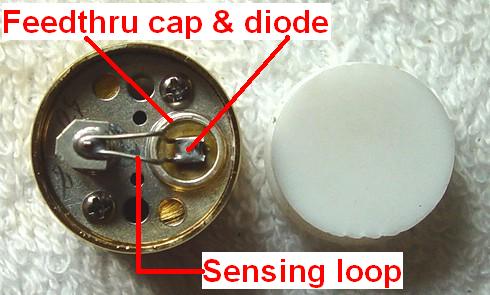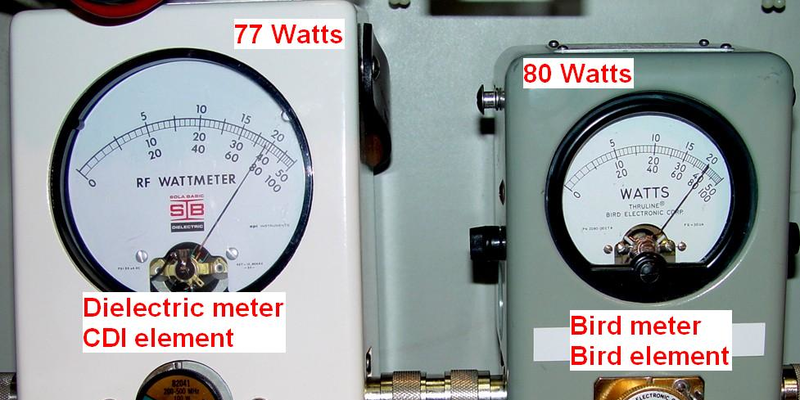When faced with a problematic Bird slug, [Robert Meister] didn’t give up. He pecked away at the slug and brought us all along for the ride. If that sentence didn’t make sense to you, read on!
Anyone who’s been to a hamfest has seen a Bird meter. The Bird Model 43 watt meter is the defacto standard for measuring transmitter power in-line. Bird meters don’t just work from DC to light though. In fact, the model 43 itself is just a bit of transmission line and a meter movement. The magic happens inside the swappable measurement element. These elements, affectionately called “slugs” are calibrated for a frequency band and power range. An example would be the model 4410-6, which works from 50 – 200 MHz, at up to 1 kW. Most hams have a collection of these slugs to go with the bands they transmit on.
 [Robert]’s problem child was a model 100E element, good for 100 watts on 400 – 1000 MHz. The meter output seemed erratic though. A bit of troubleshooting with a second meter and a known good slug isolated the problem to the 100E. The problem was isolated to the slug, but how to fix it?
[Robert]’s problem child was a model 100E element, good for 100 watts on 400 – 1000 MHz. The meter output seemed erratic though. A bit of troubleshooting with a second meter and a known good slug isolated the problem to the 100E. The problem was isolated to the slug, but how to fix it?
Slugs are sealed brass containers, each of which is calibrated to 5% accuracy at the factory. They are the closest thing you’ll find in the ham world to “no user serviceable parts inside”. Still, [Robert] had nothing to lose. He soaked the slug in a bit of Xylene solvent to loosen the glue holding the metal label on. Behind that were a painted screw and a hole for a calibration pot. We’re guessing the paint is Bird’s idea of tamper detection.
Pulling the screw out, and removing the nylon cover on the back of the slug revealed the real story. The slug contained a calibrated sensing loop, a diode, the calibration pot, and a terminating resistor. In [Robert]’s case, all he had to do was clean the contacts on the slug, and things worked fine.
For 11 years, anyway. After that, the slug started acting up again. Cleaning didn’t fix the problem this time. [Robert] ended up replacing the calibration potentiometer with a similar model from Digi-key. He re-calibrated the slug against his known good meter. It may not be a lab quality calibration, but this slug should be good for another few decades in his shack.
















Interesting. I was looking at Dip Meters, Watt Meters and the new Heathkit Precision RF Meter – HM-1002: https://shop.heathkit.com/shop/product/precision-rf-meter-hm-1002-pre-order-33
In doing this, I was wondering what the new “sensor” is in the HM1002 and can we custom make slugs/sensors/probe coils. I’m guessing something similar though not sure.
That got me looking a little closer to the elements in the Dip Meters and Watt Meters though no were near this articles detail.
Thanks for the write up, interesting to see, the info is really neat!
The guy mentioned in the article has reached wizard level in RF electronics. His Youtube channel has more tricks and knowledge than the average engeneering university.
I couldn’t find that YouTube channel – can you supply a link?
Also, the HAD article has the author as Chuck Martin, but the linked article identifies the author as Robert W. Meister?
Adam: Might want to fix that, or at least clear up the ambiguity.
The difference between the Bird and Dielectric wattmeter readings is within spec and even if the readings were erratic anyone who opens up a slug before cleaning the contacts is just looking for an excuse to open it up – and he’s not the only one to do that!
RF directional wattmeters are well worth inspecting they look very simple but their operating principle is more sophisticated than it looks.
Anyone here knows how to measure RF powers in 1-100 mW range? Frequency is 27 MHz.
Only thing I came up with is connecting an oscilloscope to a 50 Ohm resistor instead of antenna. Scope tells me the RMS voltage, and with known resistor I calculate the power.
A diode power sensor and a multimeter could be used to measure RF power of signals in the uW to mW range.
Here is an example circuit that looks good from 100 nW to 10 mW: http://www.dl5neg.de/diodesensor/diodesensor.html
The power range could be shifted up if attenuation was added before the sensor.
Thanks, I will look into it.
Nice, time to get out the FR4
Bird makes great meters. We use them on our FM transmitter at work. I’d love to get the budget to put them in a couple of other places in our transmission line to monitor reject load and dummy load values.
“I’d love to get the budget to put them in a couple of other places…”
Have you tried asking Management to give you the Bird?
B^)
Most hams that I know do not have Bird wattmeters. In fact, I only know for sure of one who does. He has it because he is a broadcast engineer and he doesn’t really count as he hasn’t been active on the ham bands in years! I can think of a couple hams that I am acquainted with that might have such devices.. it wouldn’t surprise me.. but I haven’t seen there shacks.
Why don’t we all have Bird wattmeters? Because they are too expensive! That’s typically pro equipment not amateur!
I just bough on ebay last night a Heathkit GD-1B Grid Dip Meter or Grid Dip Oscillator for $34 with shipping and a MFJ Bandswitched HF Dip Meter MFJ-203 for $50 with shipping (I actually didn’t think I’d get that offer accepted). Both are supposed to be working. I’ll probably go through and restore the GD-1B as doesn’t seem very complicated and try to make some new coils while I am at it Will be interesting to make the lower frequency coils as those should be easier. I’m not sure about the higher frequency coils as I think I may have to do some sort of multiplicative circuit off the top of my head.
I think I can resell them both also since they were priced so low. I’m way Technician level for sure… so we’ll see how the electronics, RF electronics and RF little “e” engineering goes. I’m excited still.
I figure one of those will be my portable meter in the mean time that is analog since I don’t have a West Virginia Quiet Zone modern patrol truck completed for RDF sources of static, noise, interference and jamming of living system too yet. https://en.wikipedia.org/wiki/United_States_National_Radio_Quiet_Zone.
I’m thinking the TDS-520, once repaired will go in th patrol truck or for sale.
Trying to survive the sonic assaults activities that are compounded and concealed is rough. I’m amazed how the FCC is corrupt even. The U.S.A.F. O.I.G. and O.S.I. are about the only agencies that acknowledges me and at least takes the complaints. Maybe the others do also, though haven’t responded yet. The State of Michigan directs me to the White House, Legislatures and Dept. of Treasury. .